Last-Minute NYC Holiday Gift Guide 🎁
We’ve created a holiday gift guide with presents for the intrepid New Yorker that should arrive just in time—


Homelessness may be the most intransigent social problem today facing the otherwise successful city of New York. And it’s not because city government hasn’t tried. Calling street homelessness “intolerable” in 2006, Mayor Bloomberg vowed to end it, dramatically reorganizing homeless services, introducing innovative approaches, and cleaning up the worst shelters.
Instead, homelessness has been surging upward. In April of this year, the annual survey of street homelessness found a 23% increase””an estimated 3,262 living on the street on January 30, versus 2,648 in 2011. This is far lower than the 4,395 people found in 2005, but the recent jump is troubling.
Even more seriously, family homelessness has reached record levels, with more than 43,000 New Yorkers””including 17,000 children””living in city shelters each night. At the end of August, the figure jumped to 45,000, or 40% higher than in January 2002, when Mayor Bloomberg took office. The Coalition for the Homeless contends that this past year was the worst for homelessness since the Great Depression.

In response, the city has opened nine “emergency” shelters, including two on Manhattan’s West Side, which has long been the epicenter of New York social housing policy.
City and state officials recognized the Upper West Side as the perfect neighborhood in the 1960s and 70s for placing profoundly difficult “clients,” including violent ex-cons and drug abusers, that agencies often mixed in with mentally disabled people unable to defend themselves. The combination nearly destroyed the neighborhood””even as well-intentioned West Siders grasped for solutions.
Two of the most notorious and dangerous blocks back then were 94th and 95
thStreets between West End and Riverside Drive. I know because I lived between those two blocks at 710 West End Avenue during the 1970s, at the end of the Lindsay administration and during Beame’s mayoralty. We loved our neighborhood, our building, and our apartment””but moved when conditions became intolerable. Many stalwarts, however, hung on””and regularly fought city and state placement policies. Today’s influential group, Neighborhood in the Nineties Block Association, which was founded in 1971, is the offspring of those activists.
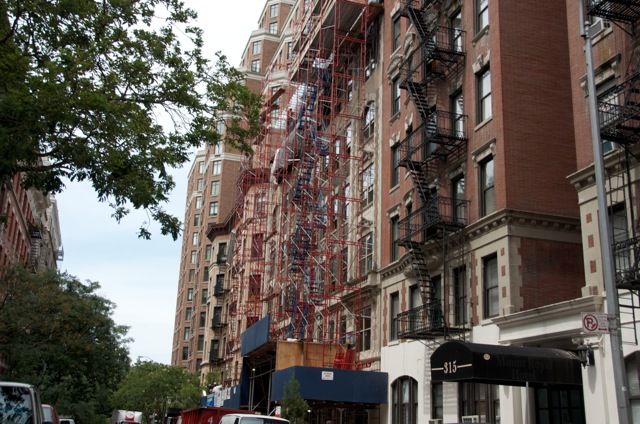
Periodically, some especially egregious incidents would burst into the news””such as the havoc wreaked by Larry Hogue. He was dubbed the “Wild Man of 96
thStreet” by the Daily News, which wrote that during the 80s and 90s he set fires under cars, heaved rocks through stained-glass church windows, masturbated in front of children, and threatened them with nail-studded clubs.
Throughout all of this, several single-occupancy-room hotels (SROs) kept operating, sometimes quietly, sometimes controversially. It’s those SROs that are now again in the front lines of the city’s shelter strategies. They’re there in part because of a 2010 New York State law””now being vigorously enforced””forbidding residential apartments from being rented for stays less than 30 days. This knocked out the lucrative European tourist trade that had kept several West Side SROs highly profitable. In November of last year, the owners of the Mont Royal (called the Apple when rented to tourists) at 315 West 94th Street, the Pennington at 316 West 95th Street (called the Candy Hostel) and the Continental at 330 West 95
thStreet (called Fresh Hotel) were fined $600,000 by the city. Astonishingly, the city’s Department of Homeless Services (DHS) then turned around and contracted to place formerly homeless people in the old tourist units””at the handsome price of $3300 per room per month.
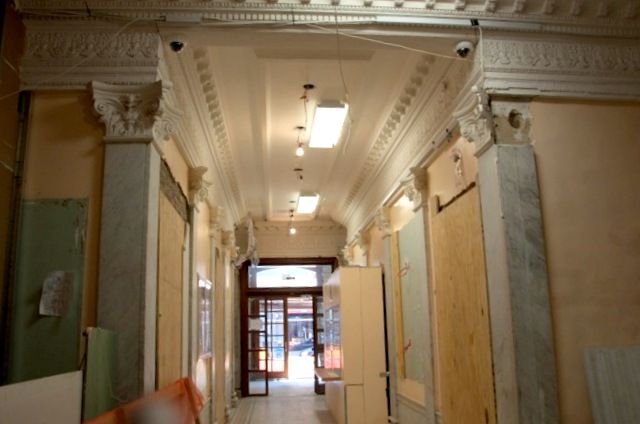
This is roughly four times what many, maybe most, current market-rate low-income SRO tenants pay, notes Robert Atkins, a young African-American musician who lives in the St. Louis on 94
thStreet. “We’re normal, working people,” he says, of himself and his fellow SRO tenants. “We’ve already lost about 40% of low-income tenants due to harassment, construction, dirt, and inadequate services.”
Indeed, even in Manhattan’s sky-high housing market, $3300 a month should buy more than a tiny room without private bathroom or kitchen. (Take a look at what Curbed says can be rented for $3,600/month right now.)
To make this difficult situation in the 90s even more confusing, the city is financing two different approaches to homelessness, back-to-back, on 94th and 95th. The 95
thStreet buildings, which will house some 400 DHS clients, are being converted to shelters. Though the term “shelter” strikes fear in the hearts of neighborhood residents all over New York, these shelters are far superior to the infamous, dangerous mass shelters of the 1980s. What’s more, they look nice from the outside, perhaps a remnant of their tourist days, but still, a good remnant.
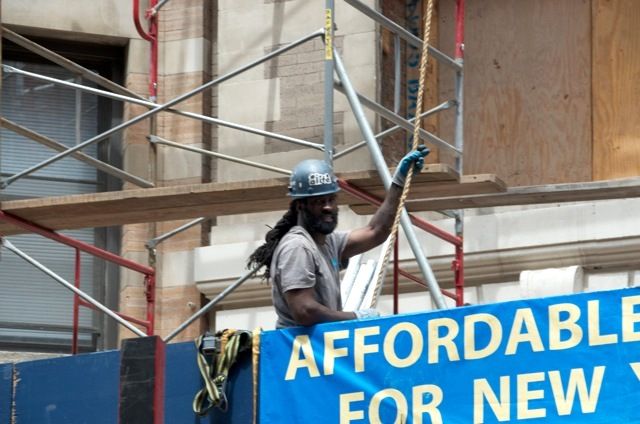
The problem is that DHS has enraged large numbers of West Siders””and their elected officials””by exercising its so-called “emergency” powers to open shelters without truly consulting the community. DHS says it has “been actively communicating with elected officials from the beginning of this process and engaged in open dialogue with community leaders.” But Councilperson Gale Brewer denies this””and Community Board 7 voted 40 to 0 against the shelters.
Sitting directly behind the Pennington is the 149-unit St. Louis, which is a project of the Department of Housing Preservation and Development””HPD rather than DHS. Essentially the city is spending $29.8 million in development costs (including a $17.3 million interest-free loan to the developer, the Lantern Organization) to convert a decrepit, run-down SRO into a showcase SRO. Well might one ask if it’s sensible to require vulnerable people with disabilities to share bathrooms and kitchens, but HPD argues that this is an efficient and relatively low-cost way to give very poor people permanent housing. But the success of the program will partly depend on how well the building is managed and how well its services to tenants are delivered.
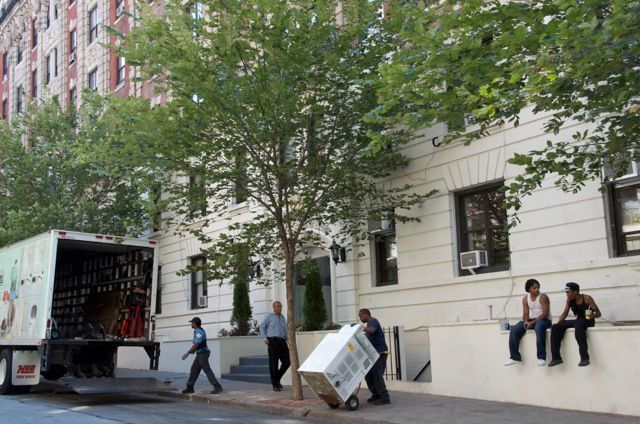
Initially, Robert Atkins was optimistic because the highly regarded Fountain House was to be the on-site service provider. “They’re very reputable,” says Atkins. “They work to help mentally disabled people become self-sufficient. They have a phenomenal track record. Then, all of a sudden: no Fountain House.” HPD says these things happen, providers don’t necessarily work out””but that Lantern House will now provide the services instead, and they will be just as good.
“This is the ultimate liberal denialism,” says Biller. “Lantern is notoriously incompetent and indifferent.”
Jessica Katz, HPD’s Assistant Commissioner of Preservation Finance and Lantern’s former executive director, is confident that Biller is wrong. “Once these buildings open,” she said, “we won’t hear the kinds of complaints you get now and the fears won’t turn out to be true.”
I certainly hope she’s right. We’ll all get a chance to judge for ourselves when the St. Louis reopens in January 2013.
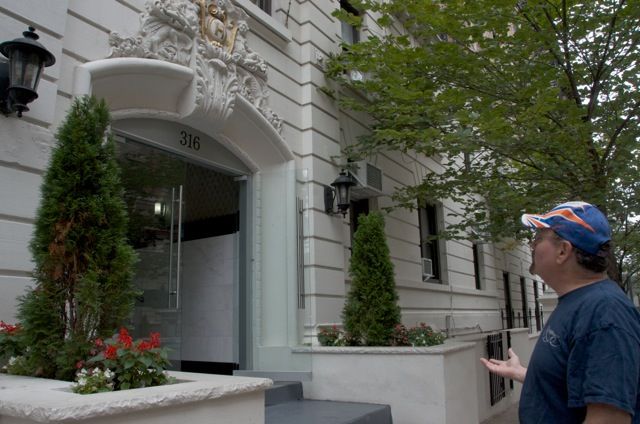
Julia Vitullo-Martin is a Senior Fellow at the Regional Plan Association and Director of its Center for Urban Innovation.
Subscribe to our newsletter